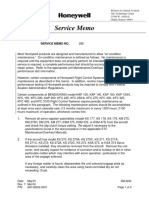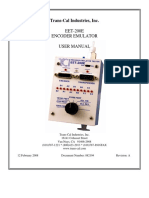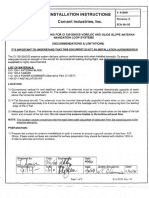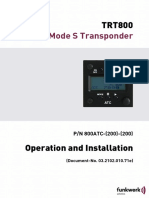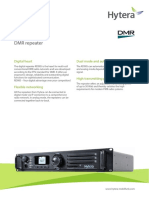Installation Bulletin: Bulletin No: 385 APPLICABLE TO: KAP 150 and KFC 150 Flight Control Systems Subject
Installation Bulletin: Bulletin No: 385 APPLICABLE TO: KAP 150 and KFC 150 Flight Control Systems Subject
Uploaded by
Kumaraswamy RSCopyright:
Available Formats
Installation Bulletin: Bulletin No: 385 APPLICABLE TO: KAP 150 and KFC 150 Flight Control Systems Subject
Installation Bulletin: Bulletin No: 385 APPLICABLE TO: KAP 150 and KFC 150 Flight Control Systems Subject
Uploaded by
Kumaraswamy RSOriginal Description:
Original Title
Copyright
Available Formats
Share this document
Did you find this document useful?
Is this content inappropriate?
Copyright:
Available Formats
Installation Bulletin: Bulletin No: 385 APPLICABLE TO: KAP 150 and KFC 150 Flight Control Systems Subject
Installation Bulletin: Bulletin No: 385 APPLICABLE TO: KAP 150 and KFC 150 Flight Control Systems Subject
Uploaded by
Kumaraswamy RSCopyright:
Available Formats
Date: Mar/97 IB #385
Rev. 4: Apr/04
P/N: 600-09385-0004 Page 1 of 4
Installation Bulletin
BULLETIN NO: 385
APPLICABLE TO: KAP 150 and KFC 150 Flight Control Systems
SUBJECT: Approval of replacement part numbers for KC 191 and KC 192
Flight Computers in existing installations
The new generation of the KC 191 and KC 192 Flight Computers has updated circuit
components with newer technology.
The new KC 191 P/N 065-0054-15 is a direct replacement for any of the following part
numbers:
065-0054-00 065-0054-05
065-0054-01 065-0054-06
065-0054-02 065-0054-07
065-0054-03 065-0054-09
065-0054-04 065-0054-12
The new KC 192 P/N 065-0042-15 is a direct replacement for any of the following part
numbers:
065-0042-00 065-0042-05
065-0042-01 065-0042-06
065-0042-02 065-0042-07
065-0042-03 065-0042-09
065-0042-04 065-0042-12
The Annunciator Dimming Adjust has been moved from the side of the unit to the face
of the unit, below the hold down screw. The adjustment is labeled BL (Brightness of
Lamps).
The Adapter Modules used in the following certifications remain unchanged, and will
function exactly the same with the new flight computers. As always, refer to the
applicable STC Installation Manual for the proper Adapter Module part numbers that
apply to your specific aircraft and flight control configuration.
Date: Mar/97 IB #385
Rev. 4: Apr/04
P/N: 600-09385-0004 Page 2 of 4
A gyro alignment procedure is included with this install bulletin and should be followed
when aligning the KFC/KAP 150 Flight Control System.
NOTE
Before aligning a KFC/KAP 150 Flight Control System with an updated KC
191 or KC 192, check the mod status of the KI 256 to see if Mod 11 has been
incorporated into the unit. Without Mod 11 installed, you might not be able to
align the KI 256 with the updated KC 191 or KC 192 due to incompatibility
issues between the units.
This installation bulletin is approved for incorporation in the following aircraft in
conjunction with the following STCs:
AIRCRAFT STC
Beechcraft A36, A36TC, B36TC SA1574CE-D
Beechcraft F33A SA1789CE-D
Cessna 172N, 172P, 172Q SA1570CE-D
Cessna 172RG SA1568CE-D
Cessna 182P, 182Q, 182R, T182 SA1770CE-D
Cessna F182P, F182Q SA1794CE-D
Cessna R182, TR182 SA1571CE-D
Cessna FR182 SA1783CE-D
Cessna U206G, TU206G SA1569CE-D
Cessna 208, 208A, 208B SA2053CE-D
Cessna 210R, T210R SA2050CE-D
Consolidated Aeronautics Lake 250 SA2069CE-D
Gulfstream Aerospace AG-5B SA00058WI-D
Mooney M20J, M20K SA1561CE-D
Mooney M20L SA2074CE-D
Mooney M20M, M20R SA2319CE-D
Partenavia AP68TP 300, AP68TP 600 SA1784CE-D
Partenavia P 68C, P 68C-TC SA1791CE-D
Piper PA-28-161, PA-28-181, PA-28-236 SA1565CE-D
Piper PA-28R-201, PA-28R-201T SA1563CE-D
Piper PA-28RT-201, PA-28RT-201T SA1563CE-D
Piper PA-32-301, PA-32-301T SA1567CE-D
Piper PA-32R-301, PA-32R-301T SA1572CE-D
Piper PA-34-200T, PA-34-220T SA1575CE-D
Piper PA-44-180 SA2321CE-D
Piper PA-46-310P, PA46-350P SA1778CE-D
Piper PA-60-700P SA1777CE-D
SOCATA TB 10, TB 20 SA1785CE-D
Date: Mar/97 IB #385
Rev. 4: Apr/04
P/N: 600-09385-0004 Page 3 of 4
11.1.3 GYRO ALIGNMENT PROCEDURES
The following system alignment is required in the KFC/KAP 150 System:
A. Remove the KC 191/192 Computer from the airplane panel. Connect
the computer to the autopilot tester with the cables provided.
B. Mount the gyro in the gyro tilt stand. Place the tilt stand in a
convenient location with reference to the autopilot computer. Level the
tilt stand using the twist adjust knobs and bubble level. Connect the
gyro air input to a regulated 4.5 in. Hg. source. Connect the KI 256/KG
258 Flight Command Indicator to the airplane harness using gyro
extender cable.
NOTE
A properly regulated and filtered air source is essential for
correct gyro operation.
NOTE
When making gyro alignment adjustments, always have
gyro set to zero in axis not under test.
C. Before applying power, make sure that the proper adapter boards are
installed in the KC 191/192 by checking the part numbers in the
windows on the top and bottom of the unit. Refer to the system parts
list for the correct numbers. Apply power to the system. All associated
circuit breakers must be installed and activated.
D. After the gyro is fully erected (ten minutes minimum run-up time),
proceed with the following.
E. Set the gyro stand to zero in both pitch and roll axis. Adjust leveling
screws for pitch and roll zero visual indication.
NOTE
It is normal for the gyro to drift during testing. To minimize
error due to drift, it is advisable to tilt the gyro and make
the scale factor adjustment quickly. After each adjustment,
return the tilt stand scales to zero and, if necessary, reset
electrical zero by adjusting the leveling screws on the gyro
tilt stand.
F. Adjust R401, Roll Null Adjust for 0.0 VDC. This is a potentiometer that
is accessible through the hole labeled RN in the front of the computer.
Measure the voltage from J19X1 (22) to the signal ground J19X2 (10)
with a digital voltmeter when making this adjustment.
Date: Mar/97 IB #385
Rev. 4: Apr/04
P/N: 600-09385-0004 Page 4 of 4
NOTE
Pitch null has been deleted.
G. Tilt the gyro to a twenty-degree right bank using the gyro tilt stand.
Adjust R1211, accessible through the hole labeled RDG on the right
side of the computer, for -4 0.2 VDC. Measure the voltage at J19X1
(22) with respect to signal ground.
H. Tilt the gyro to a twenty-degree left bank using the gyro tilt stand.
Measure the voltage at the same point as Step H. It should read 4
0.2 VDC.
If the reading in Step H exceeds +4.2 VDC, repeat Step G and reduce
the gain by one-half the amount exceeded in Step H. If Step H
measured less than 3.8 VDC, repeat Step G and increase the gain
setting by one-half the amount short in Step H. Repeat until there is a
balance between left and right bank. The proper total voltage
excursion should be 8 .4 VDC.
I. With the gyro test stand in the zero pitch position, adjust the leveling
screws on the test stand to obtain a pitch zero visual indication on the
vertical gyro. (Horizon Line aligned with 90 index marks.)
J. Measure the voltage from J19X1 (2) to signal ground with a digital
voltmeter for reference.
K. Tilt the gyro ten degrees nose-up on the tilt stand, and adjust R1212
potentiometer, located on the right side of the computer through the
hole labeled PDG, for -2 0.1 VDC from the Pitch Reference Voltage
as measured in step J. Measure the voltage at J19X1 (2) to signal
ground.
L. Tilt the gyro ten degrees nose-down on the tilt stand. The meter
should read +2 0.25 VDC from the Pitch Reference Voltage (J) at the
same point as Step K. If the meter exceeds +2.25 VDC, repeat Step K
and reduce the gain by one-half the amount exceeded in Step L. If the
meter reads less than +1.75 VDC, repeat Step K and increase the gain
by one-half the amount short in Step L.
FAA APPROVAL: The data contained herein have been reviewed by a representative
of the Federal Aviation Administration (FAA) and found to comply
with all applicable Federal Aviation Regulations. This installation
bulletin is FAA-approved, and its contents may be incorporated into
the subject aircraft.
You might also like
- Rockwell - Collins Raytheon King Air With IFIS Avionics System Manual (523-0807237) Ed 1 Rev 2Document916 pagesRockwell - Collins Raytheon King Air With IFIS Avionics System Manual (523-0807237) Ed 1 Rev 2Chi Chan100% (1)
- CMMDocument25 pagesCMMKumaraswamy RS33% (3)
- Philip E. Pace-Detecting and Classifying Low Probability of Intercept Radar (2009) PDFDocument893 pagesPhilip E. Pace-Detecting and Classifying Low Probability of Intercept Radar (2009) PDFanji.guvvala100% (3)
- King Servo SM292Document5 pagesKing Servo SM292splynNo ratings yet
- CSP 900rmm 3 - I1r12p PDFDocument942 pagesCSP 900rmm 3 - I1r12p PDFrobinyNo ratings yet
- 600-0067 Flight Max PDFDocument140 pages600-0067 Flight Max PDFKumaraswamy RS100% (2)
- Kma26 Sa 103 601-10140-0030Document14 pagesKma26 Sa 103 601-10140-0030jet100% (1)
- Kdi 572 Kdi 573 Kdi 574Document170 pagesKdi 572 Kdi 573 Kdi 574Felipe R Chaparro100% (1)
- SN4500 82009 0133 D Component Maintenance ManualDocument12 pagesSN4500 82009 0133 D Component Maintenance ManualAka MonuNo ratings yet
- Omni Bearing SelectorsDocument3 pagesOmni Bearing SelectorsVS KRISHNA KUMAR100% (1)
- Integrated Avionics Processor System: (IAPS) ICC-3111Document3 pagesIntegrated Avionics Processor System: (IAPS) ICC-3111Nemanja SedlarevićNo ratings yet
- MD41-1624,1628,1628 (5V), 1634,1638,1638 (5V) Rev2 Im PDFDocument17 pagesMD41-1624,1628,1628 (5V), 1634,1638,1638 (5V) Rev2 Im PDFHector ASNo ratings yet
- IFR ATC-600A Portable Ramp Test Set Operation ManualDocument101 pagesIFR ATC-600A Portable Ramp Test Set Operation ManualVijayakumar Arunachalam100% (3)
- Product Manual B406-4 ARTEXDocument70 pagesProduct Manual B406-4 ARTEXKumaraswamy RS100% (1)
- BA-24-34-00 Rev5Document78 pagesBA-24-34-00 Rev5Kumaraswamy RS67% (3)
- Aerospace Actuators V3: European Commercial Aircraft and Tiltrotor AircraftFrom EverandAerospace Actuators V3: European Commercial Aircraft and Tiltrotor AircraftNo ratings yet
- EET-200E Encoder Emulator User Manual: Trans-Cal Industries, IncDocument34 pagesEET-200E Encoder Emulator User Manual: Trans-Cal Industries, IncReginaldoNo ratings yet
- R9.4.1 SBDocument11 pagesR9.4.1 SBzachNo ratings yet
- Pa S-Tec Wiring 10243 Rev JDocument11 pagesPa S-Tec Wiring 10243 Rev JRaphael Elias Borges100% (1)
- Avidyne Envision EXP5000 Primary Flight Display Pilot's Guide - Avidyne - AGO08Document90 pagesAvidyne Envision EXP5000 Primary Flight Display Pilot's Guide - Avidyne - AGO08quinteroregos100% (2)
- Av80 0042Document17 pagesAv80 0042Franco PugaNo ratings yet
- SL40SVCDocument35 pagesSL40SVCgeorgeclima4103No ratings yet
- ASPEN Document 900-00012-001-T-EFD-ICADocument38 pagesASPEN Document 900-00012-001-T-EFD-ICALuis Antonio HermozaNo ratings yet
- 2015 BK Price CatalogDocument97 pages2015 BK Price CatalogDildar AlamNo ratings yet
- SM15 RS16Document30 pagesSM15 RS16jackcastelNo ratings yet
- TRC899.Install Manual 149253Document135 pagesTRC899.Install Manual 149253Andera Rosma100% (1)
- Lynx 0040-17001-01 - NGT-9000 - ImDocument248 pagesLynx 0040-17001-01 - NGT-9000 - ImJuan RodriguezNo ratings yet
- Service Bulletin - SB 08-007: AvionicsDocument5 pagesService Bulletin - SB 08-007: AvionicszachNo ratings yet
- ST3400 ImDocument116 pagesST3400 ImAde SudengNo ratings yet
- Avionics CatelogDocument9 pagesAvionics CatelogTharaka Munasinghe100% (1)
- GDC31 PDFDocument85 pagesGDC31 PDFGeeNo ratings yet
- Im2830lg (Adc-2000) PDFDocument96 pagesIm2830lg (Adc-2000) PDFJIveL JoneSNo ratings yet
- Installation Manual: 9900 Series Models 9900, 9900A and 9900BDocument68 pagesInstallation Manual: 9900 Series Models 9900, 9900A and 9900BRandy SharpNo ratings yet
- Comant II A12055 C120-200G-S InstallationDocument2 pagesComant II A12055 C120-200G-S InstallationFrank JansenNo ratings yet
- IND 5000 Inst. ManualDocument10 pagesIND 5000 Inst. ManualmglemNo ratings yet
- Adc - 90004 003 011 - 34 10 07 Im - Rev ADocument45 pagesAdc - 90004 003 011 - 34 10 07 Im - Rev Abradley100% (1)
- Barfield Sight Compass 56 101 01200 DDocument34 pagesBarfield Sight Compass 56 101 01200 DPhilip Madekufamba IINo ratings yet
- 1149 GEA71TroubleshootingReference PDFDocument9 pages1149 GEA71TroubleshootingReference PDFalex castroNo ratings yet
- Service Instructions FOR Radar RDR 2000 With Moving Map Installation and Gns 530 (GPS) InstallationDocument42 pagesService Instructions FOR Radar RDR 2000 With Moving Map Installation and Gns 530 (GPS) InstallationjohnnysNo ratings yet
- EFD1000 Install PDFDocument202 pagesEFD1000 Install PDFIlyaNo ratings yet
- Manual ELT ME406Document59 pagesManual ELT ME406Óscar David Henao MerchánNo ratings yet
- Apollo: Model SL30 Installation ManualDocument82 pagesApollo: Model SL30 Installation ManualdanielNo ratings yet
- Autopilot KFC200Document5 pagesAutopilot KFC200JuanOñateNo ratings yet
- Flight Line Maintence Manual Cessna 441Document182 pagesFlight Line Maintence Manual Cessna 441Biblioteca Brasil AviationNo ratings yet
- Bendix KR87 Install ManualDocument66 pagesBendix KR87 Install ManualMike JonesNo ratings yet
- Maintenance ManualDocument10 pagesMaintenance ManualAdrian Lau100% (1)
- Flightmax: Installation ManualDocument102 pagesFlightmax: Installation ManualEric HouvenaghelNo ratings yet
- 3300 Series Directional Gyro PDFDocument12 pages3300 Series Directional Gyro PDFHanh Trung Nguyen DucNo ratings yet
- liedsignal: I!#Endlx KLNG@Document37 pagesliedsignal: I!#Endlx KLNG@locoboeing100% (1)
- Subject: Revision C-12 To St-Un-M001 TO: All Holders of Sa227 Airframe Airworthiness Limitations ManualDocument89 pagesSubject: Revision C-12 To St-Un-M001 TO: All Holders of Sa227 Airframe Airworthiness Limitations ManualOficina Tecnica100% (1)
- G1000 System Maintenance Manual Hawker Beechcraft G58Document80 pagesG1000 System Maintenance Manual Hawker Beechcraft G58Cristian PugaNo ratings yet
- TAS6XX Install Manual Rev04 Oct05Document98 pagesTAS6XX Install Manual Rev04 Oct05herbcheckdu100% (2)
- AHS 3000+Attitude+Heading+Reference+SystemDocument121 pagesAHS 3000+Attitude+Heading+Reference+Systemgilgamesh riponziNo ratings yet
- 1172 CfeDocument161 pages1172 Cferobson lopes bezerraNo ratings yet
- Bendix King KXP 2290Document62 pagesBendix King KXP 2290Josh KatzNo ratings yet
- Flight Line Service Manual For Rate Based AutopilotsDocument115 pagesFlight Line Service Manual For Rate Based AutopilotszachNo ratings yet
- TAS 1000 & TF-500 Installation ManualDocument29 pagesTAS 1000 & TF-500 Installation ManualJonathan HamillNo ratings yet
- GMA 240 Inst ManualDocument38 pagesGMA 240 Inst ManualAxel IvaniecNo ratings yet
- GDC31 DAC InternationalDocument72 pagesGDC31 DAC InternationalSeção EletricaNo ratings yet
- WX 900 StormscopeDocument42 pagesWX 900 StormscopePericles PinheiroNo ratings yet
- HE7200A BB2327 Installation GuideDocument27 pagesHE7200A BB2327 Installation GuideАлександр КорякинNo ratings yet
- 1077 CfeDocument184 pages1077 Cferobson lopes bezerraNo ratings yet
- S TecServiceManualDocument115 pagesS TecServiceManualBruce B100% (1)
- Ki 256 sb11Document7 pagesKi 256 sb11Marcus Drago100% (1)
- Garmin GMX200 Pilot's GuideDocument148 pagesGarmin GMX200 Pilot's GuideKumaraswamy RSNo ratings yet
- Ata 23Document64 pagesAta 23Kumaraswamy RSNo ratings yet
- Ata 31Document108 pagesAta 31Kumaraswamy RSNo ratings yet
- Artex Elt ProgrammerDocument89 pagesArtex Elt ProgrammerKumaraswamy RS100% (1)
- 51QZvVoTyPS PDFDocument1 page51QZvVoTyPS PDFKumaraswamy RSNo ratings yet
- Product Manual Me 406 Ace ACR ARTEXDocument74 pagesProduct Manual Me 406 Ace ACR ARTEXKumaraswamy RSNo ratings yet
- Product Manual TPS 8701 ARTEXDocument24 pagesProduct Manual TPS 8701 ARTEXKumaraswamy RSNo ratings yet
- Product Manual G406-4 ARTEXDocument70 pagesProduct Manual G406-4 ARTEXKumaraswamy RSNo ratings yet
- Product Manual ELT 1000 ARTEXDocument62 pagesProduct Manual ELT 1000 ARTEXKumaraswamy RSNo ratings yet
- Product Manual TPS 8701 ARTEXDocument24 pagesProduct Manual TPS 8701 ARTEXKumaraswamy RSNo ratings yet
- 165e094800 (A100 S) R3 CMMDocument312 pages165e094800 (A100 S) R3 CMMKumaraswamy RSNo ratings yet
- Product Manual ELT 3000 ARTEXDocument76 pagesProduct Manual ELT 3000 ARTEXKumaraswamy RSNo ratings yet
- Q CodesDocument32 pagesQ CodesKumaraswamy RSNo ratings yet
- Nic Ad ManualDocument33 pagesNic Ad ManualKumaraswamy RS100% (1)
- Bendix King - Kmh880Document11 pagesBendix King - Kmh880Kumaraswamy RSNo ratings yet
- 250dim PDFDocument34 pages250dim PDFKumaraswamy RSNo ratings yet
- Ait135m 150 1aDocument31 pagesAit135m 150 1aKumaraswamy RSNo ratings yet
- 250dim PDFDocument34 pages250dim PDFKumaraswamy RSNo ratings yet
- TRT800Document38 pagesTRT800Kumaraswamy RSNo ratings yet
- SKY Connect Tracking AFF - SystemDocument2 pagesSKY Connect Tracking AFF - SystemKumaraswamy RSNo ratings yet
- Nat Aa 21Document41 pagesNat Aa 21Kumaraswamy RSNo ratings yet
- Ait135m 150 1aDocument31 pagesAit135m 150 1aKumaraswamy RSNo ratings yet
- BS Electronics Engineering Curriculum UpdateDocument2 pagesBS Electronics Engineering Curriculum UpdateHeart WilsonNo ratings yet
- t1321 e Instructions For Use 2202 2301 2302 2401Document24 pagest1321 e Instructions For Use 2202 2301 2302 2401Jon Claude LopezNo ratings yet
- How Much Poly-Fill Do I Need For A Sealed Subwoofer - BoomSpeakerDocument7 pagesHow Much Poly-Fill Do I Need For A Sealed Subwoofer - BoomSpeakerPeterNo ratings yet
- K4143Document8 pagesK4143eddy54No ratings yet
- Verilog - ManoDocument43 pagesVerilog - ManoMohammod Ahad ArianNo ratings yet
- DMR Repeater: Digital Heart Dual Mode and Automatic SwitchingDocument2 pagesDMR Repeater: Digital Heart Dual Mode and Automatic Switchingcrispix2000No ratings yet
- Wipro LightingDocument67 pagesWipro LightingPrem UmarwalNo ratings yet
- TDC 550 ManualDocument11 pagesTDC 550 ManualMapohoNo ratings yet
- Door Alarm: Circuit DiagramDocument2 pagesDoor Alarm: Circuit DiagramRohit GaikwadNo ratings yet
- H1 - BESS Installation Safety and Performance SpecificationsDocument9 pagesH1 - BESS Installation Safety and Performance Specificationssupershock.25No ratings yet
- Fuses & Circuit BreakersDocument95 pagesFuses & Circuit Breakersd2electrifiersNo ratings yet
- DELTA - IA-Delta - Motion - Control - Solution - Based - On - CODESYS - C - EN - 20201102Document24 pagesDELTA - IA-Delta - Motion - Control - Solution - Based - On - CODESYS - C - EN - 20201102Igor LapkoNo ratings yet
- Electrical Safety Rules-2016+FINAL+PUBLISHEDDocument77 pagesElectrical Safety Rules-2016+FINAL+PUBLISHEDSARyanNo ratings yet
- Etsi en 301 908-1Document25 pagesEtsi en 301 908-1lê doãn thiệnNo ratings yet
- UPT1000F Product Specifcation v1.5Document11 pagesUPT1000F Product Specifcation v1.5Elena PetukhovaNo ratings yet
- November 1999 Thomas Henry - Build A Tunable Noise Generator PDFDocument3 pagesNovember 1999 Thomas Henry - Build A Tunable Noise Generator PDFMeatheadMerlin100% (1)
- 9820 3582 03 User Guide MKIV Profibus Edition 06Document58 pages9820 3582 03 User Guide MKIV Profibus Edition 06blackberry45No ratings yet
- Operation Manual: Series P40-000Document53 pagesOperation Manual: Series P40-000Hai Thuong VuNo ratings yet
- Filter Fan Air Flow 110 m3/hDocument1 pageFilter Fan Air Flow 110 m3/hTarek KhafagaNo ratings yet
- Electronics Today 1979 03Document100 pagesElectronics Today 1979 03cornel_24100% (1)
- 30 A, 600 V, Ultrafast Diode: RURP3060Document6 pages30 A, 600 V, Ultrafast Diode: RURP3060Service MedisalNo ratings yet
- 05 Lindab Formo CRLDocument10 pages05 Lindab Formo CRLportocala12No ratings yet
- GV GT 250 Delphi Maf Code CheckDocument67 pagesGV GT 250 Delphi Maf Code CheckRodrigoNo ratings yet
- Nexan Cables Technology SuperconductorDocument2 pagesNexan Cables Technology SuperconductorAhmedKhaledSalahNo ratings yet
- Part 1: Induction Heating: Dr. Jiankun Yuan Prof. Yiming (Kevin) RongDocument10 pagesPart 1: Induction Heating: Dr. Jiankun Yuan Prof. Yiming (Kevin) Rongsharafudheen_sNo ratings yet
- Venus 638 FLPXDocument23 pagesVenus 638 FLPXSale SalenceNo ratings yet
- 2az Fe PDFDocument251 pages2az Fe PDFsoe moung100% (2)
- Midstage Line Amplifier 2 (MLA2 C-Band) Circuit Packs (NTK552FAE5 and NTK552FB)Document18 pagesMidstage Line Amplifier 2 (MLA2 C-Band) Circuit Packs (NTK552FAE5 and NTK552FB)Đặng LựcNo ratings yet
- Abb Motors Price ListDocument5 pagesAbb Motors Price ListMarcos DiasNo ratings yet



